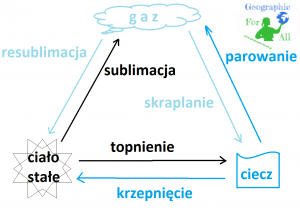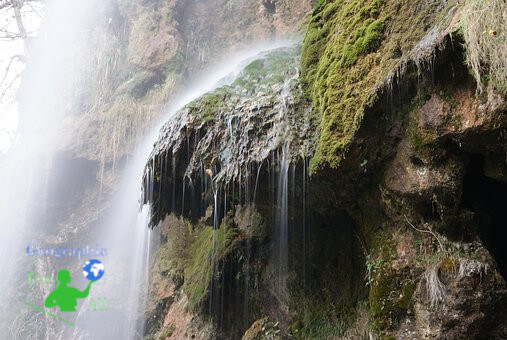The water cycle in nature/hydrological cycle is nothing but the circulation of water between the various spheres – earth, air, living organisms, soils and hydrosphere . Water moves between them, changing the state of liquid from solid to solid or gaseous, from gaseous to solid or liquid and from solid to liquid or gas. For a reminder of the physics of the names of individual changes:

When the batch of water passes the entire circulation, we are dealing with a hydrological cycle .
Water cycle in nature – causes
The main causes of water circulation are two:
- when the water goes up due to the sun, which is responsible for the temperature of the earth and air,
- when water goes down by gravity, both from the clouds to the ground, as well as flows from the mountains to the sea or seeps into the soil.
Phases of the hydrological cycle
There are two phases in the large water cycle : continental and atmospheric.
The atmospheric phase is:
- evaporation – from water (oceans, rivers, lakes, ponds), ice (glaciers, ice sheets and snow), from the ground (groundwater and soil) and from plants ( transpiration )
- movement of water vapor in the atmosphere – thanks to winds, turbulence, convection ( heat and matter transfer )
- condensation and resublimation of water vapor
- cloud formation
The continental phase consists of:
- precipitation and sediments – rain, snow, hail, hoarfrost, rime, ice, etc.
- water surface drain
- frontal, surface runoff – uses the entire surface of the earth
- linear, i.e. rivers, streams etc.
- water absorption into the soil
- retention water in the earth and the biosphere, i.e. water storage in the bodies of living organisms, ice and water bodies
- underground runoff – to oceans, lakes, ponds, etc.
In simplification:
Water balance
Water balance is a statement of water gains and losses, usually from the point of view of lands, over a specific period, usually the hydrological year for a given area . Here is the detailed annual water balance for our globe (in cubic km):
| total rainfall | = | evaporation | + | outflow from land to oceans | + | changes in retention |
| on ocean 458 thousand on land, 119 thousand total 557 thousand |
from oceans 505 thousand from lands 72 thousand total 577 thousand |
In the multi-annual balance sheet, rainfall and evaporation have the same value. But when we look at the smaller statistics, it is clear that more water evaporates from the oceans than falls on them, just as more water falls on land than it evaporates. These differences compensate for outflows.
You also need to remember about retention – some water is retained outside the circuit:
- for a short time – in lakes, rivers, soil, living organisms, hot climate zones, low altitudes above sea level,
- for a long time – in glaciers and ice sheets, permafrost, deep lakes, cold climates, at high altitude,
In shorter periods, less than 10 years, changes in retention are added to the equation, but above this time retention is ignored.
Are these 557 thousand km3 is a lot or little? The oceans have a total of 1.34 billion km3 of water (more numbers in the post about water on Earth ), but in the atmosphere there are only 12.9 thousand km3. So theoretically an example drop of water can fall to the ground about 43 times. But that’s speculation of course 🙂
And finally the picture everyone expects.



0 Comments for “Water cycle in nature, i.e. the hydrological cycle”